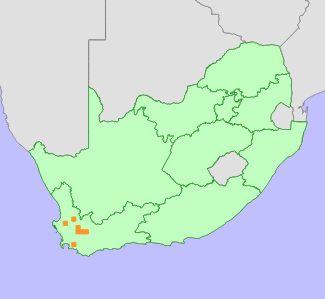Disa longifolia is a rare, seldom recorded and poorly known species (Liltved and Johnson, unpubl., Linder 1981). It flowers only in the first year after fire, and dormant subpopulations may be overlooked. This species is known from only seven localities, and was recorded only three times in the past 30 years. One of these subpopulations, which consisted of around 200 mature individuals, was subsequently lost to dam construction. The other two occur within protected montane areas, and is not suspected to be declining. A number of historical records indicate that this species formerly occurred in lowland valleys such as the Hex River Valley, Olifants River Valley in the Agter-Witsenberg area, and Riviersonderend Valley near Grabouw, where the species is now locally extinct due to habitat loss. Remaining subpopulations occur in montane areas, where they are not severely threatened.
|
Goldblatt, P. and Manning, J.C. 2000. Cape Plants: A conspectus of the Cape Flora of South Africa. Strelitzia 9. National Botanical Institute, Cape Town.
Hall, A.V., De Winter, M., De Winter, B. and Van Oosterhout, S.A.M. 1980. Threatened plants of southern Africa. South African National Scienctific Programmes Report 45. CSIR, Pretoria.
Hilton-Taylor, C. 1996. Red data list of southern African plants. Strelitzia 4. South African National Botanical Institute, Pretoria.
Liltved, W.R. and Johnson, S.D. Unpublished. The Cape Orchids - Wild orchids of the Cape Floral Kingdom.
Linder, H.P. 1981. Taxonomic studies in the Disinae. III. A revision of Disa Berg. excluding sect. Micranthae Lindl. Contributions from the Bolus Herbarium 9:1-370.
Linder, H.P. and Kurzweil, H. 1999. Orchids of southern Africa. A.A. Balkema, Rotterdam.
Raimondo, D., von Staden, L., Foden, W., Victor, J.E., Helme, N.A., Turner, R.C., Kamundi, D.A. and Manyama, P.A. 2009. Red List of South African Plants. Strelitzia 25. South African National Biodiversity Institute, Pretoria.
Victor, J.E. 2002. South Africa. In: J.S. Golding (ed), Southern African plant Red Data Lists. Southern African Botanical Diversity Network Report 14 (pp. 93-120), SABONET, Pretoria.
|
 Comment on this assessment
Comment on this assessment


